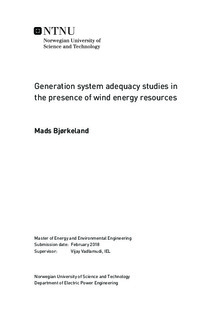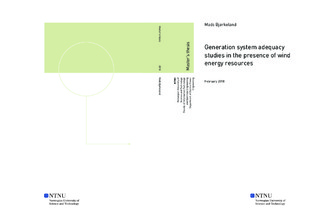| dc.description.abstract | Variable renewable energy sources like wind power are in exponential growth worldwide. One of the major challenges regarding high penetration of wind energy in the power system is the degradation of generation adequacy due to the intermittent and random nature of wind.
The deterministic approaches applied today to ensure sufficient power system adequacy are ill-fit to handle stochastic generation behaviour. In response, several generation adequacy metrics with probabilistic basis have been developed in literature. Probabilistic methods for generation adequacy assessment are crucial for securing future power system operation and renewable generation integration.
As part of a project to construct a computational framework for power system reliability this thesis focuses on generation adequacy assessment of power systems with the presence of wind power. The applied concepts include generation adequacy metrics (LOLE and EENS) and capacity credits (ELCC, EFC and ECC). To evaluate the generation adequacy of relevant test systems (Roy Billinton Test System and IEEE-Reliability Test System), MATLAB scripts that compute adequacy metrics and capacity credits have been developed and deployed. To evaluate the reliability effect from wind power generation, a wind farm has been modelled and integrated in the test systems. Evaluations applying several adequacy metrics and capacity credits have been conducted on the test systems including integrated wind power along with relevant sensitivity analyses.
From the thesis work it has become evident that the myriad of generation adequacy metrics, capacity credits and their combinations provide a powerful means of evaluating different aspects of power system reliability, thereby contributing to optimising renewable energy integration. However, the multitude of possibilities and lack of an established methodological approach makes the process of identifying the optimal metric combination a knowledge-intensive task. | |

